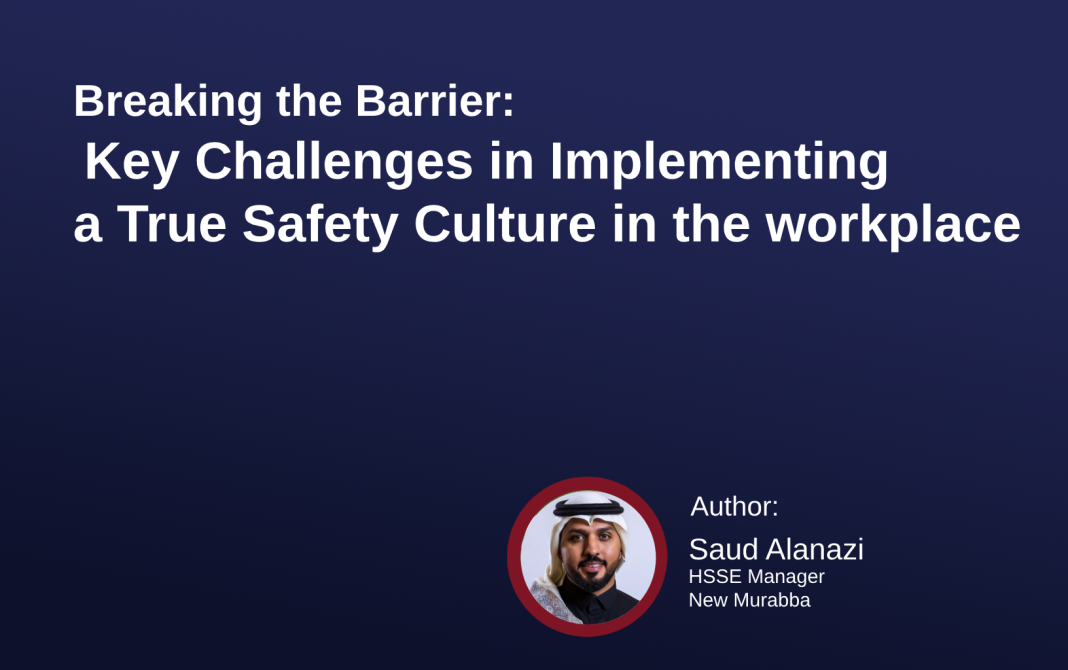In today’s rapidly evolving work environment, organizations are increasingly prioritizing Health, Safety, Security and Environmental (HSSE) performance—not just as a compliance necessity but as a cornerstone of operational excellence. However, despite the growing awareness, one persistent challenge remains: establishing and sustaining a genuine safety culture. It is one thing to implement systems, checklists, and policies; it is another to embed safety into the organizational DNA. In my experience across public and private sectors, several recurring challenges have emerged that hinder the successful adoption of safety culture.
1. Top-Down Commitment Without Bottom-Up Engagement
Leadership commitment is often cited as the foundation of safety culture, and rightly so. But too often, leadership support stops at visible gestures—wearing PPE during site visits, mentioning safety in speeches, or launching campaigns. What’s often missing is behavioral consistency and the creation of mechanisms that encourage frontline participation.
A strong safety culture is built when employees believe their input matters, that reporting hazards is encouraged—not penalized—and that safety is everyone’s business, not just the HSSE department’s job. Bridging the gap between top-down vision and bottom-up engagement remains one of the most difficult tasks.
2. Overreliance on Compliance and Auditing
In many organizations, safety is perceived as a compliance requirement. Audits, inspections, and checklists dominate the conversation, while the human element—attitudes, perceptions, and ownership—is often overlooked. As a result, safety becomes reactive rather than proactive.
A compliance-only mindset creates a “tick-the-box” culture where safety performance is measured by paperwork, not by safe behaviors. While regulatory frameworks like SBC 801, ISO 45001, and NFPA codes are vital, they must be complemented by emotional intelligence, leadership training, and cultural alignment.
3. Contractor Integration and Ownership
Many large-scale projects rely heavily on contractors and subcontractors. One of the biggest barriers to safety culture lies in the inconsistent application of safety expectations across these layers. While main contractors may enforce high standards, subcontractors may operate with minimal awareness or ownership.
To tackle this, integrate HSSE onboarding for all levels of contractors, conducting multilingual toolbox talks, and establishing a zero-tolerance approach for safety negligence. But such measures require relentless follow-up, field presence, and a collaborative—not punitive—approach.
4. Cultural and Language Barriers
With a multicultural workforce, communication challenges are inevitable. Instructions may be misunderstood, safety messages may get lost in translation, and cultural norms may conflict with risk-taking behaviors. For example, in some cultures, speaking up to a supervisor about safety may be considered disrespectful.
To counter this, effective training must go beyond translation—it must be visual, interactive, and scenario-based. Peer-led mentoring and embedding safety champions from different nationalities can foster shared responsibility and cross-cultural learning.
5. Lagging Indicators over Leading Indicators
Many companies still rely on lagging indicators like incident rates or lost-time injuries as the primary metrics of safety performance. These indicators, while important, only reflect what has already gone wrong.
A mature safety culture must prioritize leading indicators—such as hazard reporting frequency, participation in safety walks, number of near-misses reported, and employee feedback. These metrics help organizations stay ahead of risks and foster a learning environment.
6. Lack of Digital Integration
In an era of rapid technological advancement, many organizations have yet to harness the full potential of digital tools in safety management. AI-powered cameras, real-time incident tracking apps, and digital PTW (permit-to-work) systems can significantly enhance visibility, accountability, and responsiveness.
However, adoption remains slow due to budget concerns, resistance to change, or lack of technical training. Integrating digital tools should be seen not as a luxury, but as a critical enabler of proactive safety culture.
Final Thoughts
Building a safety culture is not a project—it’s a journey. It requires time, patience, and a collective mindset shift. It starts with leadership, but it thrives when every individual feels empowered and accountable. The future of safety in the workplace lies not just in stronger regulations but in fostering environments where safe behavior is instinctive, not instructed.
As HSSE professionals, our mission is not only to prevent incidents but to inspire belief: that every role, every task, and every voice matters in shaping a culture where safety is truly lived—not just listed.
About the Author:
Eng. Saud Alanazi is a seasoned Corporate HSSE Manager at New Murabba, with over 10 years of experience in the Health, Safety, Security, and Environmental (HSSE) field. He has led safety strategies across mega projects and high-profile organizations including STC and PepsiCo. He holds a bachelor’s degree in mechanical engineering (First Class Honors, UK) and is certified in NEBOSH IGC, NFPA92, IOSH, KPI, ISO 45001, PMP and RMP. In addition he is an approved NEBOSH trainer, certified HSSE auditor, and experienced consultant, supporting the development and implementation of safety systems across diverse industries in the Middle East.







